CHINESE NEW YEAR CUSTOMS
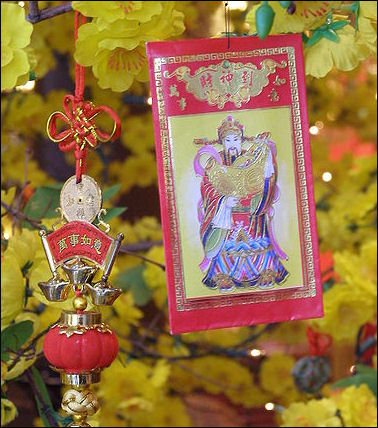
red envelopes
Chinese Lunar New Year is a time when evil spirits, ill fortune and bad luck are swept out and various observances and activities are taken to welcome the new year. Grudges are forgotten; arguments are settled; old things are thrown out. People buy new clothes, preferably red ones, and get hair cuts to symbolize a fresh start for the new year. On the streets and in homes they greet one another by clasping and shaking hands and telling each other Happy New Year — “Kung hey fat cho” (“wishing you prosperity”) in Cantonese or “Xin nian hao” in Mandarin.
Chinese are required to settle all their financial and personal debts before the New Year. The New Year season is also a time when wives and mistresses struggle for the attention of their men and the revelations of affairs and divorce filings reach their peak. Many migrant workers return home to find their wives with babies that can not possibly be theirs. To wish someone a happy and prosperous new year in Mandarin Chinese, say , "gong xi fa cai, xin nian kuai le" (“Wish you happiness and prosperity! Happy New Year!").
In 2009, government officials were told to tone down their partying, gift giving, banquets and sightseeing trips using government money over Chinese New year as part of a crackdown on corruption. New Year is a time when a lot of expensive gifts or cash are given out to win favors, seal shady business deals and say thank you for some favor given.
Good Websites and Sources: Wikipedia article on Chinese New Year; Wikipedia ; History of Chinese New Year history.com ; Chinese Calendar PaulNoll.com PaulNoll.com ; Wikipedia article on traditional holidays Wikipedia ; Wikipedia article on Chinese Calendar Wikipedia ; Chinese Astrology Chinatown Connection on Astrology Chinatown Connection ; Chinatown Connection on the Chinese Zodiac Chinatown Connection ; Wikipedia article on Chinese Astrology Wikipedia
Articles on Holidays and Festivals in this Website: CHINESE LUNAR CALENDAR AND CHINESE ACCOUNTING OF TIME factsanddetails.com; CHINESE HOLIDAYS factsanddetails.com ; TRADITIONAL FESTIVALS IN CHINA factsanddetails.com ; QINGMING (TOMB-SWEEPING DAY): HISTORY, PRACTICES AND BANS factsanddetails.com ; HUNGRY GHOST MONTH factsanddetails.com ; MID-AUTUMN FESTIVAL AND MOONCAKES factsanddetails.com ; CHINESE NEW YEAR: FAMILIES, FIREWORKS AND PHONES factsanddetails.com ; CHINESE NEW YEAR FIXTURES: LONG TRIPS HOME, MIGRANT WORKERS AND PAYING DEBTS factsanddetails.com ; CHINESE NEW YEAR GALA TV SPECIAL factsanddetails.com ; factsanddetails.com ; LOSAR (TIBETAN NEW YEAR) factsanddetails.com ; TIBETAN RELIGIOUS FESTIVALS factsanddetails.com
RECOMMENDED BOOKS: “China'S Spring Festival” by Liu Shiyu Amazon.com; “The Spring Festival” by Li Song Amazon.com; “Holidays Around the World: Celebrate Chinese New Year: With Fireworks, Dragons, and Lanterns” by Carolyn Otto Amazon.com; “Lunar New Year (Celebrate the World)”by Hannah Eliot and Alina Chau Amazon.com; Chinese Festivals Good Luck Life: The Essential Guide to Chinese American Celebrations and Culture”by Rosemary Gong and Martin Yan Amazon.com; “Chinese Festivals” by Wei Liming Amazon.com; “Mooncakes and Hungry Ghosts: Festivals of China” by Carol Stepanchuk and Charles Choy Wong Amazon.com; “Moonbeams, Dumplings & Dragon Boats: A Treasury of Chinese Holiday Tales, Activities & Recipes” by Nina Simonds , The Children's Museum Boston, et al. Amazon.com; “The Demon King and Other Festival Folktales of China” by Carolyn Han, Ji Li (Illustrator), Jay Han Amazon.com; “Festivals of China's Ethnic Minorities” by Xing Li Amazon.com
Important Days and Events of Chinese New Year
There are different traditions, food,, activities and superstitions for each of the 15 days of Chinese New Year celebration. The second day has traditionally been reserved for visiting the in-laws on the mother’s side of the family, since married daughters were considered a part of the husband's family in ancient China and cannot spend Chunjie with her parents. Frances Lee wrote in Woman's Day: “The times have changed, but the tradition of spending the second day with the mother's side of the family is still a special custom that many families keep. The celebration concludes on the 15th day with the Lantern Festival, where children carry around lanterns and families eat glutinous rice balls together. [Source: Frances Lee, Woman's Day, February 13, 2021]
"The reunion dinner on New Year’s Eve is perhaps the most important event of the holiday, as it's the only time of the year many people can travel home and spend time with their families. Many of the dishes served at the reunion dinner and throughout the holiday carry important meaning. According to Food Network, fish signifies wealth and prosperity as the Chinese word for “fish” sounds similar to the word for “plenty.” Other traditional fare includes; rice cakes, which symbolize success in one’s career; oranges which symbolize good fortune; dumplings, which symbolize wealth; glutinous rice balls which symbolize family togetherness and reunion; and long noodles that symbolize long life).
The three-day Spring Festival itself is mellower. People visit friends and relatives and exchange New Year greetings. Families get together for large meals and eat special New year foods. Fish is always served on New Years’ Eve as a symbol of prosperity and wealth since the word for "fish" sounds like the world for "surplus." People also eat dumplings. Sometimes they have coins inside. On the first day people usually stay home or visit local temples. Sometimes long lines form outside temples as people gather to pray for prosperity and good fortune for the coming year. The second and third days are spent visiting family and friends and distributing lucky red packets filled with money. Many Chinese stay indoors on the third day of Chinese New Year because they believe if they go outside they will get into an argument.
Temples hold boisterous fairs with lots of charms, amulets and games that are supposed to bring good luck. People visit fortunetellers, light incense and joss sticks and make offerings to bring good fortune in the coming year. There are special variety shows and singing contest on television. Celebrities and politicians call for world peace. People toss joss sticks into a fire at Taoist temples and businesses pay to have dragon dances done in front of their offices to bring good luck. There are special dances to go with the animal whose year it is. Cantonese children wish “Ging Xi Fa Cai”, or Happy and Prosperous New Year, to their parents and family elders by presenting them with a pair of mandarin oranges. Children then receive hong bao.
Chinese New Year also welcomes a new animal from the Chinese zodiac. a repeating 12-year cycle where each year represented by an animal and its attributes.” The year, 2021 was “the Year of the Ox, and Chinese astrologers believe 2021 will be a stable year as the ox is dependable and diligent. In rural areas, the village square fills with people selling paper and silk lanterns, plastic toys, cold rice noodle and sweet deserts. On New Year’s Day, addresses of local officials are broadcast in the loudspeaker system and officials give liquor and pastries to village elders. Some village have basketball and badminton tournaments.
Preparations for Chinese New Year
Around the house everything has to be cleaned and repaired. Sometimes this process begins weeks in advance and has to be finished before New Year begins when all brooms must be hidden lest they sweep away good fortune entering the house. In some places rubbish has to be placed outside the house and no one uses knives or scissors for the first three days of the new year.
People buy paper lanterns, red-and-gold paper holiday decorations, and good luck scrolls to decorate their homes. Houses are decorated with the animal signs for the new year, images of bearded figures dressed in traditional gowns and children decked out in silk costumes. There are often competitions to see who can have the best display. Not having a display can cause a loss of face. In the cities buildings and main streets are lit with lights and decorations.
Many people decorate their homes in red. Red banners are hung on the front door to welcome the new year. Some families hang traditional poetic couplets, paintings, paper cutting — always red. In the old days families hung wood block prints known as nian hu on the gates of their houses. Theses prints contained images of the gods of good luck and were supposed to attract good luck and protect against evil. The custom is dying out and most houses don’t have them anymore.
Family alters are cleaned, often according to customs specific to a particular region or dialect. The 24th day of the 12th lunar month is important to Taoists. It is when they ‘send their gods to heaven.” The Kitchen God is offered sweet cakes on this day to ensure that he gives a good report of the family to the Heavenly Emperor.
The "elders first" rite is the central ritual of the Chinese New Year. Family members kneel and bow on the ground to everyone older than them: first grandparents, then parents, siblings and relatives, even elderly neighbors.
Ushering in Chinese New Year
Preparations for the new year generally begin in earnest two weeks in advance when streets are decorated with lanterns and streamers; shops sell paper money, drums and costumes; the number of street vendors increases; and parents buy firecrackers for their children. In the days before New Year charms are pinned on doors and gateposts to ward of evil spirits, houses are thoroughly cleaned, everything is decorated with the Chinese zodiac animal for that year; and people prepare themselves to paaaarrrty.
Before midnight families traditionally have made offerings to their ancestors and young people kowtowed to their elders and the elders gave them money in return, with the money being in the form of crisp new bills or shiny new coins placed in red envelopes embossed with gold characters. After this the family sat together and ate dumplings and New Year cakes. These days, many families still follow these customs but many others sit around their televisions and watch New Years Eve specials and parents give their children presents much like Westerners do on Christmas.
At midnight at temples people ring a bell to signify the end of the old year and a wish for good luck in the new year. On the streets billions of firecrackers are set off; bottle rockets are fired a bucketful at a time; and paper dragons are carried through the streets by teams of young men who throw firecrackers and dance around the strings of firecracker that people throw at them. Fireworks are lit to scare away evil spirits and have a good time. In some cities there are rules restricting the use of fireworks but this not the case in the countryside, towns and small cities.
Hongbao and Spring Festival Gifts
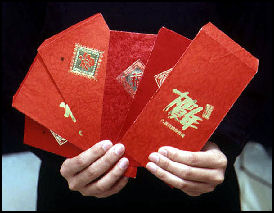
Hong Bao
Money is the most popular Chinese New Year gift. It usually given in a red envelope to children and unmarried adults. The tradition of distributing gift money has been practiced since the Han dynasty (206 B.C.E to 220 CE). The custom is said to have originated from the tradition of using coins to fend off evil spirits. Clocks, pears and scissors should not be given as gifts — as these all have unfavorable connotations.
Gifts such as gift-wrapped baskets of delicacies, flowers or small mandarin orange trees are given. Department stores and Carrefour hypermarkets feature things like red gift boxes of Peking Duck, mixed nuts and rice wine. Floral displays are important and special flower markets spring up to provide flowers and fruit trees for them. Plants and flowers represent growth and flowering trees promise fruits to come. The markets in Hong Kong sell kumquat trees, peonies, peach blossoms, willow branches, narcissus and mandarin orange trees. Peaches are a symbol of longevity. Kumquats and mandarin oranges represent wealth. Many decorations and gifts are red. Red is an auspicious color associated with the new year. It symbolizes life, happiness and good luck.
“Hong bao” (red packets filled with money), also known as “lai see” or “ya suo qiang” (year end money), are given out to bring good fortune and success and ensure that nobody, particularly kids and single people, begin the new year short of cash. The amounts vary depending in who is doing the giving and the age of the recipients. The envelopes often have Chinese characters that translate to “good fortune” or “good in business” or some such thing printed on them, and are sometimes accompanied by Chinese paper cuts.
Hong bao are given mostly to children by relatives. In Hong Kong businesses distribute lai see with the company logo embossed in gold and single youth good-naturedly demand money from older friends and relatives. Employers give bonuses in the form of lai see packs stuffed with bank notes.
Zeng Jing wrote in Asian Creative Transformations, “Chinese people love giving gifts. Distributing gift money in red envelopes on New Year’s Eve is especially important. Some may criticize the commodification of an ancient tradition; but at the end of the day (or evening) is it really about money? From the public perspective such practices have little to do with money...The the amount of money placed in the red envelope is small. Most red envelopes I have received, for example, contained less than $2. In other words, it doesn’t matter how much you send to your friends, it is the well wishes sealed in the envelope that matter more. In Chinese culture gifting is all about exchange. When you receive something from others, you want to give something back in return. When I send a red envelope to my friends, they send me one in return immediately. It is akin to a greeting, like asking: “how are you?” You are expected to ask the same question back. [Source: Zeng Jing, Asian Creative Transformations, February 23, 2015]
Digital Hongbao
Zeng Jing wrote in Asian Creative Transformations, “My phone kept beeping but both my hands were busy. I was wrapping dumplings (bao jiaozi), experiencing my first Chinese New Year in Australia. Whenever I am far away from home I receive a steady stream of messages from friends and family on New Year’s Eve. I anticipated heavy traffic this time. But when I turned on WeChat, a WhatsApp like Chinese messaging app, I was both delighted and astonished: as well as the predictable best wishes, I received money. I mean real money! As I have been abroad during the Chinese New Year over the past several years, I haven’t enjoyed the opportunity to receive or give away red envelopes. Thanks to mobile technology I am now back in the game again. The messaging app allows users to send virtual red envelopes, which can be deposited into mobile payment accounts. [Source: Zeng Jing, Asian Creative Transformations, February 23, 2015 ~]
“Red envelopes are mostly given to children by older family members as a way to show their concern for the younger generation. The red envelopes exchanged on WeChat, however, abandon the hierarchical aspect of this practice: it is often used as bonus, one that you give in addition to the conventional New Year greeting message. The WeChat app is now part of the entertainment for the New Year celebration; that is, it allows for the gamification of Chinese New Year. WeChat does not just provide one-to-one sending of red envelopes; it also has this feature to send a lump sum to a group of people, which WeChat disburses in several envelopes with random amounts; reception is on a ‘first come first served’ basis. For instance my family have a WeChat group of 14 members; red envelopes are ‘thrown out’ at least once by each member on New Year’s Eve. The money involved is minimal but the excitement is huge. Another WeChat group is my high school alumni. With a total of 61 members, the giving and taking game lasts throughout the whole evening. ~
“An important participant in this year’s virtual red envelope game is China Central Television’s (CCTV) New Year Eve’s Gala. One of the most watched shows in the world, the Gala this year gave out RMB 500 million yuan (USD 80 million) gift money during the four-hour show. Once the signal is sent out, WeChat users shake their phones to win the red envelope. Throughout the show 20 million people participated in this game, shaking their phones 11 billion times. ~
“While WeChat is the most popular platform for gift money exchange this year, some other tech giants have also introduced similar services. Alibaba, China’s largest e-commerce company, launched its own gift money campaign: RMB 600 million yuan (USD 96 million ) was given away in virtual red envelops to its users during the New Year. According to Alibaba, 240 million virtual red envelopes were sent through its payment tool on sanshi, the day before Chinese New Year. The economic benefits that accrue from such a massive nation-wide exchange of virtual capital is significant. Because both companies have expanded their business into the world of money-market funds, it becomes essential for them to win Chinese people’s digital wallet. Imagine the potential market: there are millions of people like me who get hooked on WeChat’s in-app payment tool after using this new feature. To top up my WeChat payment account to give away more envelopes, I connected the app with my bank account. As WeChat is building its payment service into a one-stop platform where I can pay for my offline spending (taxi, phone bill, food ordering…), I may start to use my WeChat wallet more often when I am in China. ~
Chinese Communist Party Electronic Red Envelopes
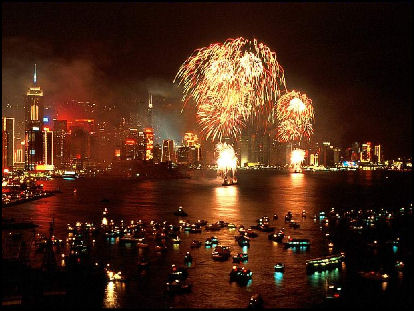
New Year in Hong Kong
In 2016, AFP reported: “China's Communist Party has found a new way to court technology-savvy web users, setting phrases by President Xi Jinping as the password for electronic "red envelopes" of online cash offered ahead of the Lunar New Year. With Chinese e-commerce booming, Internet giants Tencent and Alibaba both enable users to send lucky money electronically, and the Communist Party has jumped on the bandwagon, teaming up with both the companies. [Source: AFP, Yahoo News, February 5, 2016]
“A total of 300,000 yuan ($50,000) is being made available over three days on Alipay, the online payment service of Alibaba, founded by Jack Ma, one of China's richest men. To stand a chance of collecting it, users must get a passphrase from an account owned by the ruling party's powerful organisation department and run by the official Xinhua news agency on WeChat, Tencent's hugely popular instant messaging service.” On one day the “set phrase was "You will earn what you worked for," following "As long as we persevere, dreams will come true," on Thursday — both of them from Xi's 2016 New Year speech, repeatedly broadcast on television nationwide on December 31.
“"Every effort you make will be rewarded twice as much in 2016," the organisation department, which is in charge of Communist Party members' promotions and demotions, said on the WeChat account. “Ma's firm was contributing to the effort, it signalled, saying that the money "had nothing to do with party membership dues" and was instead "raised by Xinhua's website and Alipay on their own". The statement had been read more than 100,000 times by midday. But the money was all gone within seconds of becoming available at 11am. Users were sceptical, with one poster on China's Twitter-like Weibo describing the exercise as "weird", adding: "Party and government agencies just need to do their own job well." “Another asked: "Did anyone actually get one?"
New Year’s Eve Village Rituals
“The day of New Year's Eve is clear enough that the sun pierces the chill, heralding the coming change of season,” Megan K. Stack and Barbara Demick wrote in the Los Angeles Times. “It it is time to change the faded banners decorating the house. Li climbs a bamboo ladder and, as his son stands below peeling off strips of tape, they hang the auspicious couplets purchased for the New Year. Across the top of the gate, gold letters on a strip of red paper read: "Happiness and fortune will prevail." [Source: Megan K. Stack and Barbara Demick, Los Angeles Times, February 20, 2011]
“As the sun drops low, the menfolk begin one of the most important rituals of the holiday, burning fake paper money for their ancestors. The earth crunches underfoot as they walk through the wheat fields. Seven generations of Li ancestors are buried here. There are no gravestones, just simple mounds of dirt for each of the families. Without uttering a word, Li squats with a cigarette lighter and ignites a bundle that looks like old yellow paper towels. He explains later that his father, who died in 1989, was cremated in keeping with the Communist directive against traditional funerals, and his ashes were buried somewhere in a small box in the field. "Really, I don't remember exactly where. I just approximate," he says with a sheepish shrug.” [Ibid]
“The women aren't invited to the ritual. By Chinese tradition, they're not really part of the Li family, maintaining their birth names for life. Instead, they spend the day cooking. They roll out rounds of dough the size of coasters and with nimble fingers wrap them into dumplings that will be the main attraction of the festivities. On New Year's Eve, dumplings are to be eaten at midnight, but the Lis don't want to wait.” [Ibid]
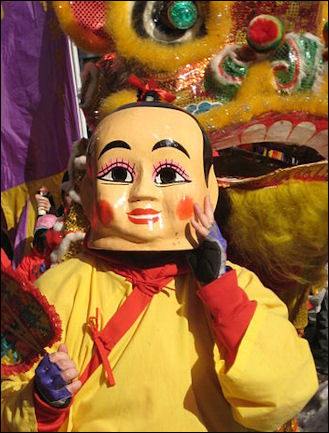
Chinese New Year parade
in Boston “By 7.30 p.m., the older men are seated around a low coffee table in a chilly sitting room with motorbikes parked behind the sofa. A bamboo pole lies across the entrance from the courtyard to keep out Nian, a mythical monster who is said to emerge at the New Year to attack children. Loud noises from the firecrackers and fireworks are also supposed to scare him away.” [Ibid]
“Although Li is younger, he also joins them; he has a prominent place in the family: the eldest son of the eldest brother. The men pick disinterestedly at the food with their chopsticks, lavishing more attention on the baijiu, distilled alcohol, that they're pouring into tiny shot glasses. The women flit in and out of the room, eating a few bites, but they don't sit for more than a few minutes. They begin to drift into a bedroom off the courtyard to watch television.” [Ibid]
“Outside, the younger people have gathered on the crossroads to set off the fireworks. Little children clutch cigarette lighters in tiny fists in anticipation of lighting the sparklers. The older boys scamper about with excitement. The men carry out the boxes wrapped in shiny red paper. Each family has bought its own stash of fireworks, but they'll set them off at the crossroads so everybody can see who could afford to buy what. Across the fields, splashes of color from richer villages are visible in the sky.”
“A few stragglers on their way to dinners in neighboring villages roar by on motorbikes or three-wheel cars, dressed in their holiday finery. They shout out New Year's greetings as they pass. By now the fireworks are popping. Each fresh explosion drenches the street scene for a split-second like a strobe, and then it's gone.”
Chinese New Year Religious Rites in the 19th Century
In 1899, Arthur Henderson Smith wrote in “Village Life in China”: “The very first aspect in which Chinese New Year presents itself, no matter in what part of the world we happen to meet it, is that of noise. All night long, there is a bang! bang! bang! of firecrackers large and small, which, like other calamities, “come, not single spies, but in battalions.” The root of all this is undoubtedly connected with religion, as in other similar performances all over the world. But though the explosion of gunpowder is the most prominent, it is far from being the most important act of New Year worship. [Source: “Village Life in China” by Arthur Henderson Smith, Fleming H. Revell Company, 1899, The Project Gutenberg; Smith (1845 -1932) was an American missionary who spent 54 years in China. In the 1920s, “Chinese Characteristics” was still the most widely read book on China among foreign residents there. He spent much of his time in Pangzhuang,a village in Shandong.]
“There is the despatch of the last year’s kitchen-god, generally on the twenty-third of the twelfth moon, and the installation of his successor at the close of the year. On the last evening of the year, there is the family gathering either at the ancestral temple, or should there not be one, in the dwelling-house, for the worship of the tablets of the past few generations of ancestors. In some parts of China ancestral tablets are comparatively rare among the farming and working people, and the place of them as regards the practical worship at New Year’s eve, is taken by a large scroll, containing a portion of the family genealogy, which is hung up, and honoured with prostrations and the burning of incense.
“On the morning of the second day of the new first moon, perhaps at other times also, all the males of a suitable age go to the family or clan graveyard, and there make the customary offerings to the spirits of the departed. There has been considerable controversy among foreigners expert in Chinese affairs as to the true value of these various rites from a religious point of view, but there is no doubt on the part of0 any one that they constitute a most essential ingredient in a Chinese New Year, and that in the present temper of the Chinese race, a New Year without such rites is both inconceivable and impossible. We do well, therefore, to place Religious Rites prominently in our catalogue.
Chinese New Year Social Obligations
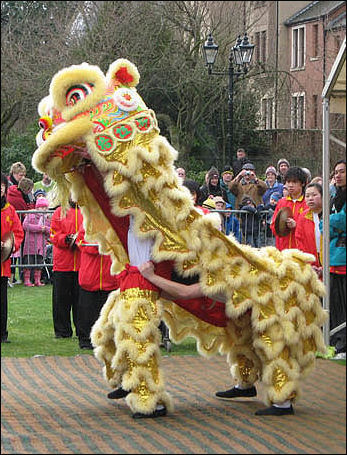
lion dance
Didi Kirsten Tatlow wrote in the New York Times’s Sinosphere: Holidays can be joyful times, bringing together long-separated family members. They can also be the most dreaded times for precisely that reason. Things may go horribly wrong under the weight of mutual expectations, and escape is difficult. In China, where an individual’s business is the family’s business, the questions are unremitting: “How much do you earn? Why don’t you have a better job? When will you marry? When will you have children? How did you get so fat?” Throughout the ordeal, the cornered victim must maintain at least the appearance of filial respect to his or her elders. [Source: Didi Kirsten Tatlow, Sinosphere, New York Times, January 27, 2017]
Arthur Henderson Smith wrote in “Village Life in China”: “While the ceremonies connected with the dead are important, they are soon disposed of once for all, and that they do not form a part of the permanent New Year landscape. It is quite otherwise with the social ceremonies connected with the living. The practice of New Year calls, as found in some Western lands is a very feeble parody of the Chinese usage. We call on whom we choose to call upon, when we choose to go. The Chinese pays his respects to those to whom he must pay his respects, at the time when it is his duty so to do and from this duty there is seldom any reprieve. For example, not to press into undue prominence local practices, which vary greatly, it may be the fashion for every one to be up long before daylight. After the family salutations have been concluded, all but the older generation of males set out to make the tour of the village, the representatives of each family entering the yard of every other family, and prostrating themselves to the elders who are at home to receive them. [Source: “Village Life in China” by Arthur Henderson Smith, Fleming H. Revell Company, 1899, The Project Gutenberg]
“This business goes by priority in the genealogical table, as military and naval officers take rank from the date of their commissions. Early marriages on the part of some members of a collateral branch of a large clan, late marriages on the part of other branches, the adoption of heirs at any point, and other causes, constantly bring it about that the men oldest in years are by no means so in the order of the generation to which they belong. Thus we have the absurd spectacle of a man of seventy posing as a “nephew”—or, if worst comes to worst—as the “grandson” of a mere boy. One often hears a man in middle0 life complain of the fatigues of the New Year time, as he being of a “late generation,” is obliged “to kotow to every child two feet long” whom he may happen to meet, as they are “older” than he, and in consequence of this inversion of “relative duties,” the children are fresh as a rose, while the middle-aged man has lame knees for a week or two!
“If the first day is devoted to one’s native town or village, the succeeding ones are taken to pay calls of ceremony upon one’s relatives living in other towns or villages, beginning with the mother’s family, and branching into relationships the names of which few foreigners can remember, and which most cannot even comprehend. That all this social ceremony is upon the whole a good thing cannot be doubted, for it prevents many alienations, and heals in their early stages many cases of strained relations. Yet, to us such a formal and monotonous routine would prove insufferable. To the Chinese, these visits are not only an important part of New Year, presumptively they are in real sense New Year itself. Every visit involves a “square meal,” and (from the Chinese point of view) a good time. To omit them, would be not only to deprive oneself of much pleasure, it would be to commit a social crime, which would almost certainly give great offence.
Chinese New Year Dances
New Year's parades feature dragon dances and lion dances. Describing a lion dance held at one parade, Bruce Edward Hall wrote, "The Lion appears, his long, twisting body trailing out behind that huge brilliantly-colored head, both frightening and fantastic with its rolling eyes, his flowing mane, and his snapping jaws ready to consume money offered by store owners eager to have the beast come and frighten those evil spirits away another year."
The red-and-gold silk and papier-mâché dragons used in Chinese New Year festivities sometimes are 100 feet long and carried by 30 men. Their arrival is announced by the banging of drums, cymbals and gongs. Sometimes a lion dancer dressed in a leopard-skin strongman outfit carries the head and a dragon teaser lights and tosses combustible powder to simulate the dragon's fiery breath. The partying often goes on all night. “One reveler told AP, “No one can sleep, not even with ear plugs in.” In the morning the streets are littered with firecracker papers and debris.
Regional Chinese New Year Celebrations
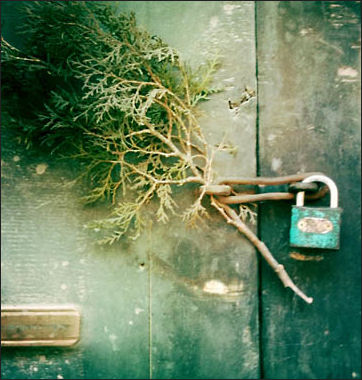
New year custom in Shanxi
In villages, people dress in costumes and beat drums and stage parades. Certain regions, towns and cities have their own special holiday programs. In Beijing, for example, there is Flower Fair and Temple Fair and folk performances with stilt walking, acrobatics, lion dance, folk boat dances and donkey dances. In Canton, people exchange "good luck" peach flowers and greet each other with "”Kung Hei Fat Choy”" ("Wishing You Success and Prosperity").
In many cities there are special New Year’s markets with stalls sell a variety of things such as paper lantern and good luck scrolls to decorate their homes. In Shanghai, markets with hundreds of stalls selling holiday decorations, traditional flowers and seasonal delicacies and stay open all night. Shanghai Gardens is lit up with colorful lanterns and features dance troupes performances. On New Year’s Eve people gather at Jing’san Temple to ring the temple bell.
Shehou is a celebration unique to northern China. Originally a ritual that honored the gods of the heaven and earth, it features community street performances with dances, masks and face painting. Children chew on watermelon seeds and are placed on poles and paraded through the streets.
Some urban Chinese say they find the New Year’s traditional activities boring and the social obligations with family and coworkers a chore.
Chinese New Year Foods
A number of dishes are prepared for New Year that are supposed to bring good fortune and happiness. Among them are fish, which symbolizes abundance, and black moss, who names sound like “wishing for abundant wealth.” The meal itself represents a renewal of family bonds. In some places, after the meal people wash their hair with special pomelo leaves before midnight.
Chef, Kian Lam Kho told Oprah Magazine: "The idea of an elaborate reunion dinner is that you have to include all sorts of stuff. You have to have fish, you have to have chicken or duck, or pork. It's to indicate that you're so successful during the year — that you can afford all of this, and carry it over to the new year." Fish, fruit and dumplings are also symbols of luck and prosperity — so you can expect these to be served over Chinese New Year as well.
New Year feast foods are often served whole — fish with the head and tail, chicken with their head and feet, and whole oranges — all of which are said to bring good luck. Long noodles, which are said to represent longevity, are served uncut. These days salmon is often served instead of traditional carp as the featured fish dish. Some families eat only vegetarian dishes on the first day of New Year and eat only air-cured products on the second day.
Everyone eats special Chinese New Years cakes. On the streets vendors sell barbecued pork and Chinese sausages. Fancy restaurants serve up dishes like Good Fortune Ahead made with braised meat and crab roe sauce and Hit the Jackpot made with crispy pork knuckles. One man told the International Herald Tribune: “Every family had to buy...a candy box that is usually round or octagonal shaped, featuring all kinds of Chinese candies such as sugar lotus, sun-dried seeds, golden chocolate coins and so on. Some fancy ones even open to three levels, containing the widest selection of sweets. There were also lots of glutinous rice ball and crispy rice cakes.”
Chinese New Year Homophones: Foods That Sound Good
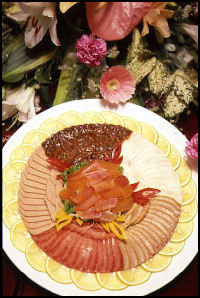 Vera H-C Chan of Yahoo News wrote: “The Chinese New Year takes playing with food to a whole new level, and paronomasia is the name of the game. Sound—namely homophones, words that sound alike but have different meanings—determines many of the ritual foods that make the Chinese feast, not taste. For example: "fish" (yu, also sounds like "surplus" (yu in Cantonese and Mandarin. Eating fish at the start of the year therefore symbolizes abundance to come. This kind of wordplay exists in other languages, but as far as I’m aware, not to the extent of Chinese," says Dan Jurafsky, a Stanford University professor and author of The Language of Food: A Linguist Reads the Menu. "The Chinese have this pattern not just in food, but in other customs, and there is also a long history of puns in Chinese art." The following is a list of ten essential Chinese New Year foods and their homophonic meanings according to Yahoo News. [Source: Vera H-C Chan, Yahoo News, February 19, 2015 +]
Vera H-C Chan of Yahoo News wrote: “The Chinese New Year takes playing with food to a whole new level, and paronomasia is the name of the game. Sound—namely homophones, words that sound alike but have different meanings—determines many of the ritual foods that make the Chinese feast, not taste. For example: "fish" (yu, also sounds like "surplus" (yu in Cantonese and Mandarin. Eating fish at the start of the year therefore symbolizes abundance to come. This kind of wordplay exists in other languages, but as far as I’m aware, not to the extent of Chinese," says Dan Jurafsky, a Stanford University professor and author of The Language of Food: A Linguist Reads the Menu. "The Chinese have this pattern not just in food, but in other customs, and there is also a long history of puns in Chinese art." The following is a list of ten essential Chinese New Year foods and their homophonic meanings according to Yahoo News. [Source: Vera H-C Chan, Yahoo News, February 19, 2015 +]
“1) Fish & Surplus: "The most ubiquitous New Year's pun is this: yú ("fish") = yú ("surplus")," writes Victor Mair, professor of Chinese Language and Literature at the University of Pennsylvania, in an email to Yahoo. Naturally, including a dish of plenty for the celebration portends good luck. "Eating fish will help you have more than enough during the coming year." 2) Oranges & Good Fortune: Enter a Chinese household bedecked with New Year's decorations, and you'll invariably find bowls of Mandarin oranges (chang-gwo). Native to China, the fruit is the go-to gift when visiting friends, family, or colleagues during this time of year. Chang-gwo sounds like chéng-guô, which means "produce results," so bringing oranges or having piles of them is a symbol of abundance and good fortune. 3) Rice Cakes & Riches: The sweet, copper-colored rice flour cake nian go sounds like the word niángao, which means "year higher" or "year ascends." The Chinese interpret that as either getting richer every year or taller every year. (Teenage boys in search of growth spurts are keen on the latter interpretation.) The main ingredients for this steamed cake are sweet rice flour, brown sugar, almond extract, red dates, and sometimes sesame seeds. +
“4) Kumquats & Luck: The homonym and the homophone are at work with the tiny kumquat. Gum-gwat translates into "gold orange," but it also contains the character for "lucky." Here's a twist: After the kumquat made its way into Europe in the 19th century, it was bestowed a new botanical name after the man who brought the fruit to the new continent, Robert Fortunel. The botanical namesake: fortunella. 5) Dumplings & Transitions: Some claim that the word jiaozi (dumplings) sounds similar to go-chi or "to take one's leave," and they stretch that to symbolize "bidding farewell to the old and ushering in the new." That could just be an excuse for a midnight dumpling party: Families gather 'round to make some tasty savories, then they eat them right around midnight, as the old year gives way to the new. 6) Lotus & Fertility: If you break down the word for lotus seed, lianzi, you get "lian," which means "successive" and "zi," which means "seed." "Zi" can also be the word for "children." Many Chinese interpret that as meaning "children, one after another," and eat lotus to boost fertility. Sliced and sugared lotus root and lotus seeds often make the New Year candy tray, which also includes coconut strips, red melon seeds, water chestnuts, and black melon seeds. +
“7) Turnips & Good Omens: Familiar to dim sum diners and more common in southern Chinese cooking, the turnip cake also turns up on the New Year's table. Turnip is a radish (tsai tou), which also sounds tsai tou, the word for "good omen." 8) Pomelos & Abundance: The giant pomelo (yaau) sounds just like the Chinese word for "to have," another allusion to abundance and prosperity. The fruit's round and hefty size also symbolizes family unity, and the color yellow connotes gold. 9) Dried Oysters & Good Business: "Dried oyster" (ho see) is similar to the Chinese word for "good business" or "happy events." For the New Year, people braise it and pair it with something called hair seaweed. See the next slide for more on that. 10) Seaweed & Prosperity: "Gung Hay Fat Choy" is an oft-used New Year's greeting, which roughly translates to "congratulations and be prosperous." While fat choy means "prosperity" here, fat choy is also a type of algae known as hair seaweed or black moss. Paired with dried oysters (ho si), they make up a dish that combined sounds like the word for "wealth and good business." +
Regional Chinese New Year Foods
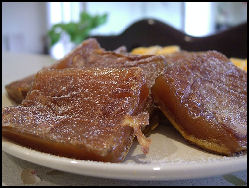
Guangdong New Year cake
In Hong Kong and southern China people eat dishes that sound almost the same as phrases used for wishing good fortune. These include “fachohoxi” (lightly fried oysters, black moss seaweed, pork and oyster sauce), which sounds like the words for wealth and good business and “niango” (a rice cake made with brown sugar and coconut), whose name mean implies career advancement. Among the other dishes are “lobakgo” (rice cake made with radish), “chuanhap” (assorted sweets), and “yagok” (fried dumplings). Chicken, pork and fish are popular because they are believed to invite good fortune
In Beijing people eat boiled “jiaozi” (dumplings stuffed with meat), spring rolls and steamed Chinese buns, often decorated with red ribbons with good luck slogans such as “Happiness Will Come” or “Congratulations.” The dishes are often frozen before New Year so that women aren’t so busy cooking during the holiday period. In Shanghai, women often spend days making salted and dried chicken and pork dishes. Jellyfish, pan-fried rice cakes, deep friend spare ribs and fried shrimps with chili sauce are often served there.
Hong Kong and Guangzhou favorites include minced codfish, braised pork shank, turnip pudding, tangerines, peaches, and special dishes that symbolize silver and gold. In Fujian, some people eat a dish called "Buddha’s Favorite," made with abalone, mushroom and bamboo piths, and is so named because, according to legend, a monk lept over a wall and broke his vegetarian vows to eat it.
Importance of New Year’s Dumplings in the 19th Century
In 1899, Arthur Henderson Smith wrote in “Village Life in China”: “The customs of different parts of the wide empire doubtless vary, but probably there is no part of it in which either dumplings or some similar article are not inseparably associated with New Year’s Day, in the same way as plum-pudding with an English Christmas, or roast-turkey and mince pie with a New England Thanksgiving. As compared with Western peoples the number of Chinese who are not obliged to practice self-denial either in the quantity or the quality of their food, and in both, is small. The diet of the vast mass of the nation is systematically and necessarily abstemious. [Source: “Village Life in China” by Arthur Henderson Smith, Fleming H. Revell Company, 1899, The Project Gutenberg]
Even in the case of farmers’ families who are well enough off to afford the year round good food in abundance, we do not often see them indulging in such luxury. Or if the males of the elder generation indulge, the women and children of a younger generation are not allowed to do so. Hereditary economy in the item of food is a marked Chinese trait. To “eat good things” is a common phrase denoting the occurrence of a wedding, a funeral, or some occasion upon which “good things” cannot be dispensed with. To eat cakes of ordinary grain on New9 Year’s Day, and not to get any dumplings at all, is proverbially worse than not to have any New Year.
“Moreover, the keen joy with which every member of a Chinese family looks forward to the dietetic aspect of their New Year, the still keener joy with which every member is absorbed in devouring all he can get of the best there is to be got, and the scarcely less keen joy with which each one recalls the details of the menu when the family is once more launched upon the Sahara of ordinary fare—these are full of suggestion and instruction to Occidentals who habitually have so much to eat that they seldom secure the best sauce of gnawing hunger, and are more likely than not to be bored by being asked out to an elaborate dinner with many courses. The most robust imagination finds it impossible to conceive of a Chinese who should take this view of what always appeals to the finest feelings of his nature. There is therefore much reason in placing Dumplings in the forefront of a Chinese New Year.
Image Sources: 1) Hong Kong fireworks, Hong Kong tourism office; 2) Dalian market, Beifan; 3) Guangdong cakes, Wikipedia; 4) Others, Taiwan Tourism office ; Wiki Commons; Asia Obscura
Text Sources: New York Times, Washington Post, Los Angeles Times, Times of London, National Geographic, The New Yorker, Time, Newsweek, Reuters, AP, Lonely Planet Guides, Compton’s Encyclopedia and various books and other publications.
Last updated September 2021
